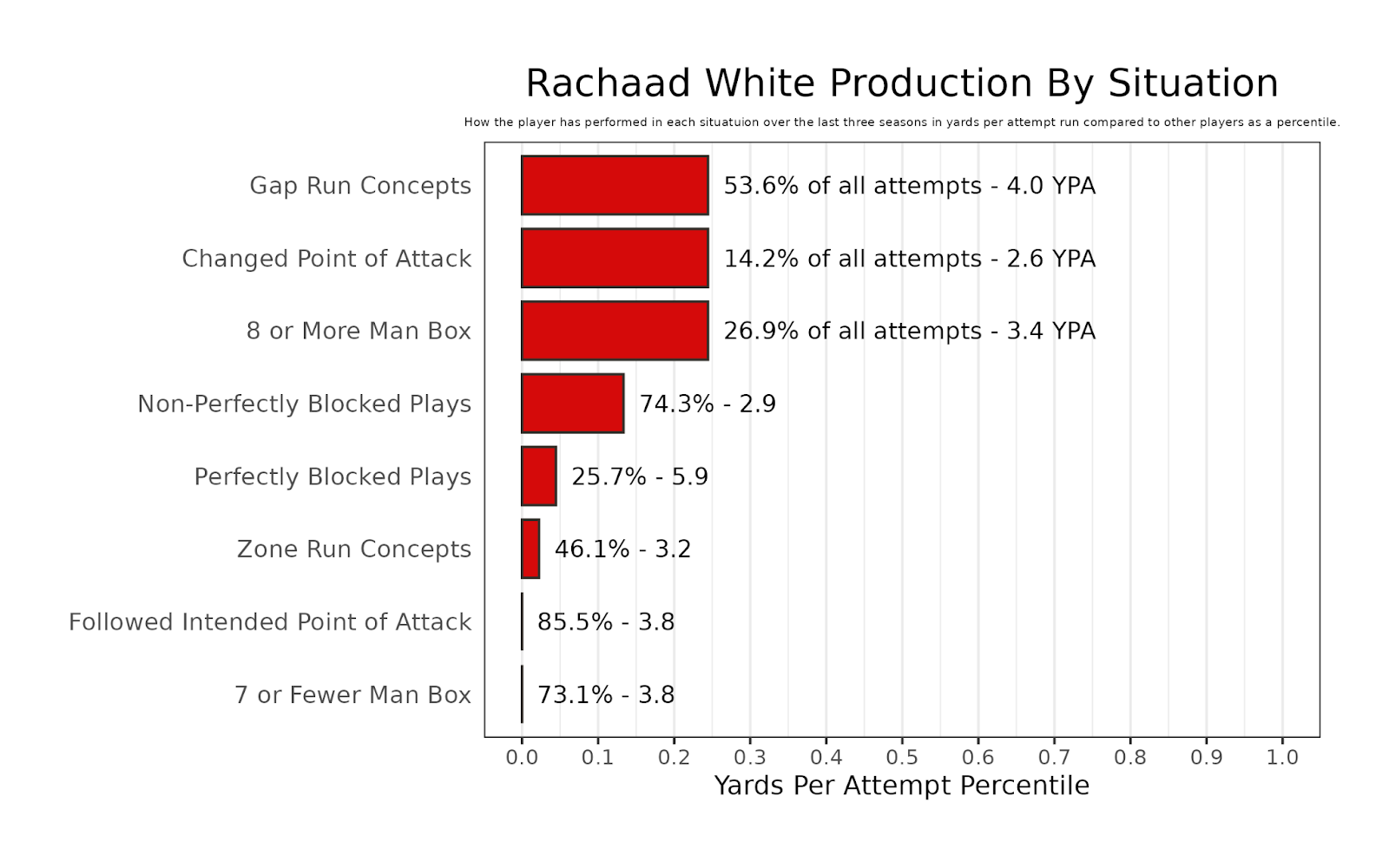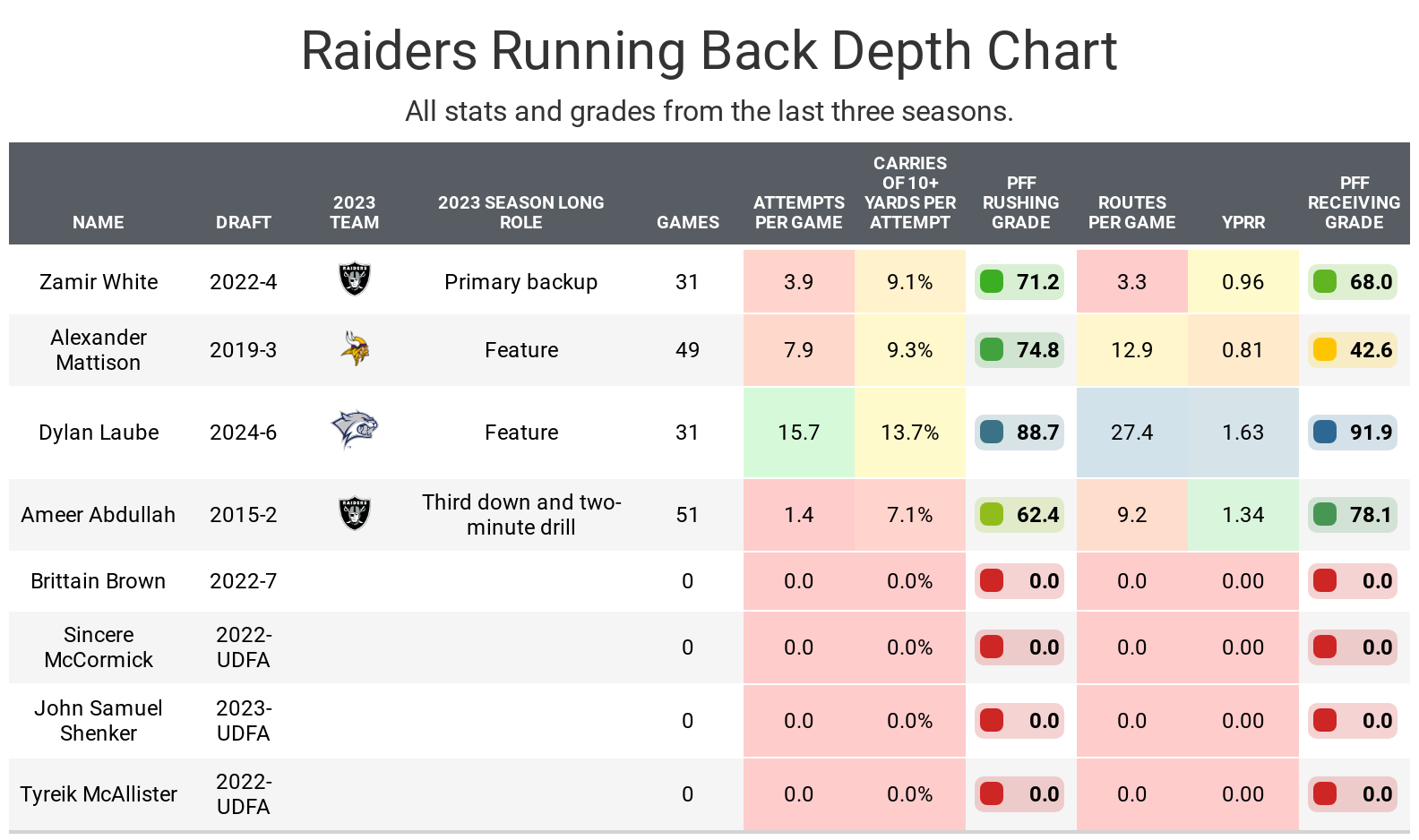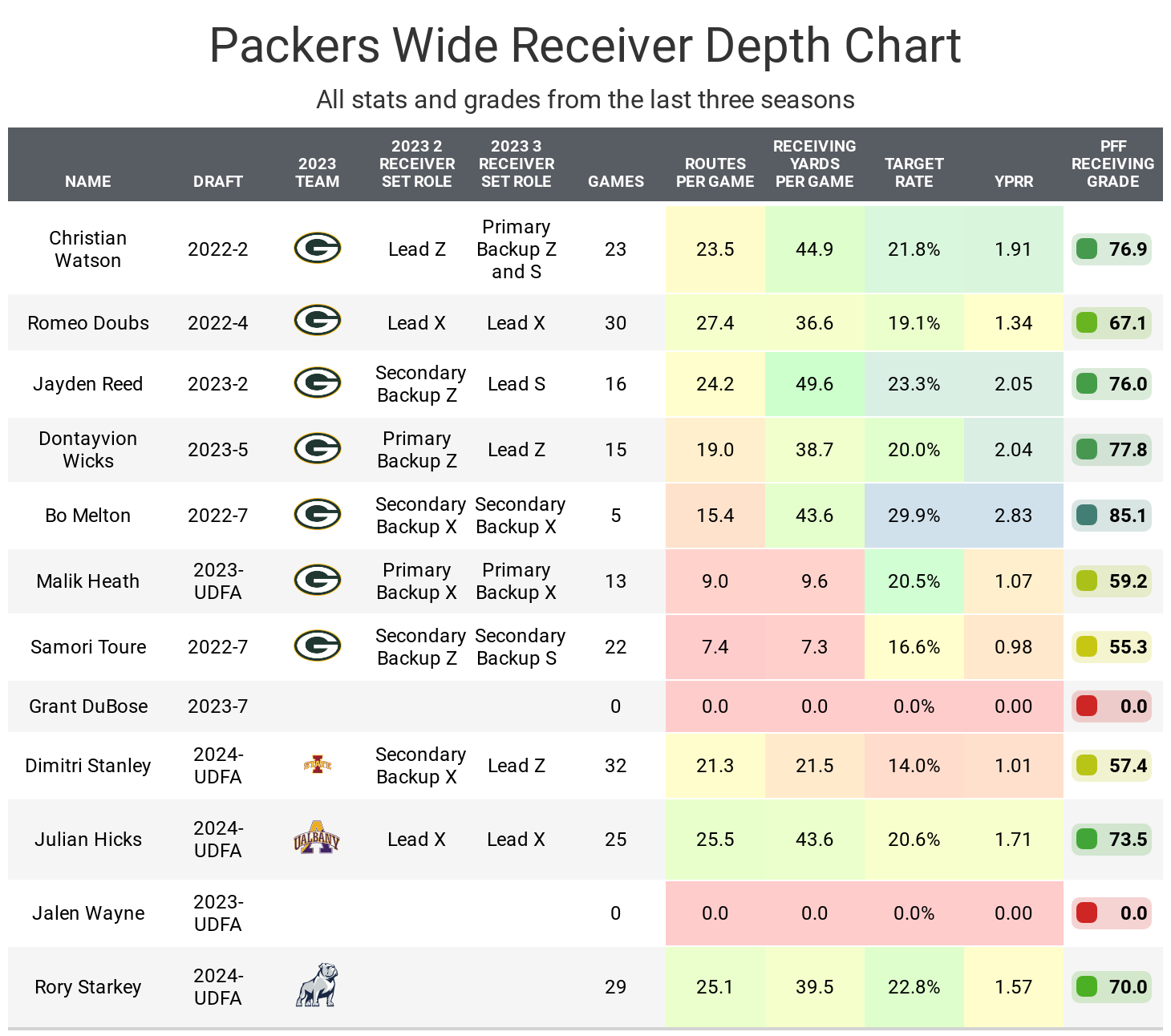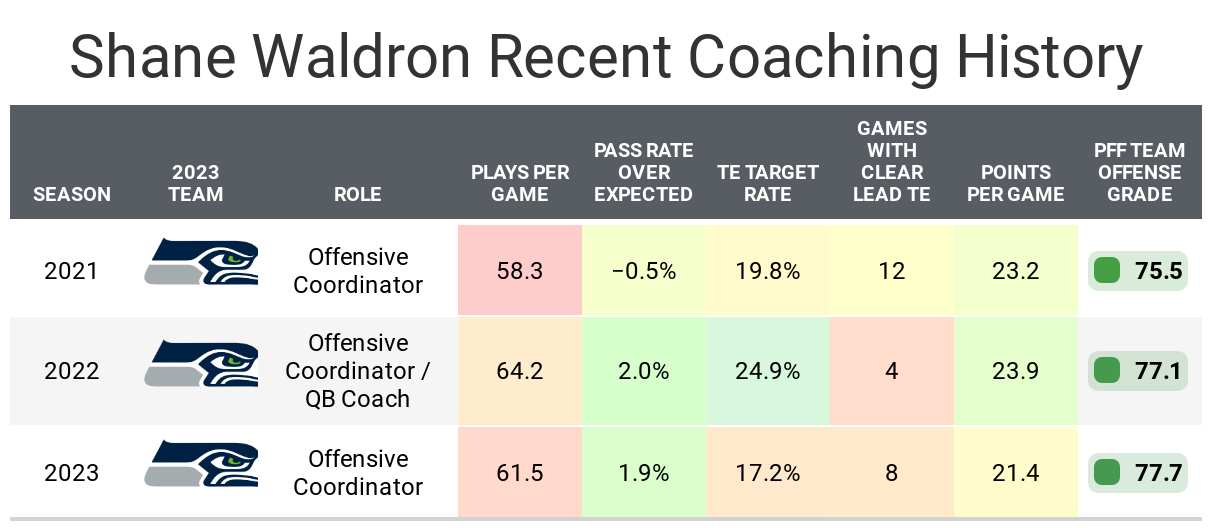• A lack of efficiency could doom Rachaad White’s fantasy potential: White will remain a top-five fantasy running back if he maintains his current volume, but several indicators suggest a potential decline in that workload.
• Christian Kirk‘s decreasing role: Kirk's snap count could decrease for the second consecutive year, making it unlikely that he will match the touchdown total he achieved in 2021.
• Dominate your fantasy draft: Subscribe to PFF+ to get full access to PFF’s suite of fantasy football tools, including the fantasy mock draft simulator, live draft assistant, fantasy draft rankings, cheat sheets and more! Click here to subscribe!
Estimated reading time: 15 minutes
According to my rankings, these five players all have ADPs at least one round higher than where they should be drafted. Even if they fall slightly relative to ADP, they are players you should avoid drafting.
Last updated: 7:15 a.m. Monday, September 2
RB Rachaad White, Tampa Bay Buccaneers (ADP: 4.04, From consensus ADP)
White finished last season as the overall RB4, thanks to his volume and health. With Leonard Fournette no longer on the Bucs' roster, White's carries and routes per game significantly increased from his rookie season to last year.
This increased usage led to White posting some of the best receiving volume numbers among running backs. He made big plays in the passing game, boosting his yards per route run average, even though his target rate decreased.
However, White's rushing efficiency was below average for the position. He moved the chains less frequently and broke off fewer big plays than other running backs.
While it's easy to point to the offensive line as a reason for White's inefficiency—and it did play a role, as he experienced perfectly blocked plays less often than most running backs—the fact remains that even on perfectly blocked plays, his yards per carry average was lower than those of many other running backs in the league.

White became the feature last year, with his snap rates in different situations looking somewhat similar to Christian McCaffrey‘s. The Buccaneers tried Chase Edmonds, Sean Tucker and Ke’Shawn Vaughn as the primary backup to White at various times throughout the season; none of them stood out or were able to take time away from White.
The Buccaneers drafted Oregon standout Bucky Irving in the fourth round of the 2024 draft, and he is likely to serve as the primary backup this season. While Irving will probably play around 25% of the Bucs' offensive snaps to start the season, there is at least a chance (given Irving’s efficiency in college and White’s lack of efficiency in the NFL) that Irving will take over as the primary early-down back at some point this season.
Recent comments by head coach Todd Bowles suggest the team is happy with Irving and that he adds an element they didn’t have last season:
“He [Irving] can stick his foot in the ground and run the ball. More importantly, he can make the first guy miss more often than not, and, you know, that’s a rare trait to have in this ballgame, especially when so many guys can tackle well and get to the ball real fast. To make the first guy miss and potentially have big-play ability, that’s something that we didn’t have a lot of last year.”
White is the taller, more significant back of the two, so even if Irving cuts into White’s playing time on early downs, White could remain in control of the goal-line snaps and short-yardage situations. And while Irving showed some promise as a receiver, White has been more efficient in that area, so it’s less likely White will lose the receiving job.
Liam Coen joins the Buccaneers as the new offensive coordinator. When Coen was the Rams' offensive coordinator, his team ran more plays than expected. However, they didn't throw much to their running backs or run many plays overall. This change will likely benefit the fantasy value of the Buccaneers' wide receivers more than it will help White.
Volume is the most important factor for a running back. White had plenty of it last season, though he was not efficient. While efficient running backs are more likely to maintain their volume, White exemplifies a player who had volume but risks losing it this season if he doesn't make more of his opportunities.
If White had performed better on a per-play basis last year, he would be a first- or second-round pick. Instead, he remains a risky choice. While he has top-five potential, there's also the risk he might not be the starter for the Buccaneers very long. Every other running back with an ADP in the first four rounds isn’t at risk of a significant decrease in playing time.
RB Zamir White, Las Vegas Raiders (ADP: 7.01)
White is being drafted as a fantasy starter but is unlikely to have a role that sustains fantasy success.
It’s evident the team has no intentions of using him on third downs. Last season, White became the primary running back for the Raiders during the final four weeks after playing six snaps a game at most as a rookie in 2022 and 14 snaps a game at most over the first three quarters of 2023.
During those five games last season, he played one of a possible 34 snaps on third-and-5-plus, with Ameer Abdullah taking those reps.
Through two weeks of the preseason, the Raiders have consistently taken White off the field in these situations, with Alexander Mattison, Dylan Laube and Ameer Abdullah all taking those reps with the starters and primary backups.

He will similarly not be used much in two-minute drills. Over the last four weeks of last season, he played seven of a possible 27 two-minute drill snaps, again losing snaps to Abdullah.
Dylan Laube has taken all of these first-half snaps in the first two weeks of the preseason. Not being the primary running back in two-minute drills takes a running back's odds of being a fantasy starter from 72% to 51% in any given week.
White is also at risk of losing some of his early-down snaps. This concern has been amplified by the presence of offensive coordinator Luke Getsy, who has a history of utilizing running back committees. In Chicago, Getsy had David Montgomery and Khalil Herbert splitting work, and during his time with the Packers (though not as offensive coordinator), Aaron Jones often shared snaps with either Jamaal Williams or A.J. Dillon.
In the preseason, White started each of the two games, but in both instances, Mattison took over for a drive on his own, with White returning the following drive. This is notable because most lead backs didn’t play in the second week of the preseason, and those who did, like Isiah Pacheco or James Cook, typically played 100% of the first snaps before being sidelined for the remainder of the game.
During the second quarter of the second preseason game, White rotated with Laube. Laube handled third downs and the two-minute drill, while White took most of the early downs. However, Laube also managed to sneak in on a first-and-10 play.
White even started the third quarter of the preseason game, which is highly unusual for a presumed starting running back. At that point, the Raiders had their backup quarterback in, along with their fourth- to sixth-string wide receivers, their third-string tight end, and only one offensive lineman projected to start at the beginning of training camp. Notably, two typical starting offensive linemen didn’t play at all, and three veteran linemen had already been taken out of the game.
It’s almost unheard of for a starting running back to play in the second half of any preseason game, except for rookies working their way up the depth chart. In the past three seasons, the only running back to play in the second half of the second preseason game and finish as a top-50 fantasy running back was Devonta Freeman in 2021. That was during a preseason game with the New Orleans Saints, and he only later signed with the Baltimore Ravens after their running backs suffered injuries.
While sometimes players see extended preseason action due to injuries at their position, the Raiders had six other running backs available in this game. This suggests that the Raiders might not be as confident in White as they are in the rest of their offensive starters. White, Mattison, Laube and Abdullah all sat out the final preseason game, and all four made the final roster. They are one of roughly 10 teams to keep four halfbacks on the roster.
Given these factors, White falls out of the conversation as a reliable fantasy starting running back. If you’re drafting a third running back, it would be wiser to target someone with a higher upside. For example, the Bengals' backfield situation is still uncertain, but whoever emerges as the starter there is likely to score more fantasy points than White.
WR Christian Kirk, Jacksonville Jaguars (ADP: 6.11)
Kirk has developed into one of the more dependable slot receivers in the league. His PFF receiving grade has stabilized in the mid-70s in recent seasons, and his fantasy value has benefited from a high volume of pass routes combined with a decent target share.
Playing in the slot allows him to maintain a high catch rate, making it easier to accumulate PPR points consistently. While he may not have the explosive, game-changing performances of other elite receivers, Kirk has been a reliable fantasy starter who can be counted on for steady production.
In 2022, Kirk's fantasy value was further bolstered by a career-high eight touchdowns, most of which came when the Jacksonville Jaguars were within 10 yards of scoring. Kirk was targeted on eight of 35 routes in those situations, resulting in six touchdowns. At the time, Marvin Jones Jr. and Zay Jones were the primary outside wide receivers.
However, in 2023, Kirk saw a significant drop in red zone opportunities. He was targeted on only two of 15 routes in similar situations, with Calvin Ridley taking over most of those high-value targets. This shift in red zone usage was the main reason for Kirk's decline in fantasy points per game last season.

Last season, it seemed like the Jaguars were transitioning Kirk into a more specialized role, primarily utilizing him in 11 personnel as a slot receiver rather than as an every-down option. During the preseason, both Calvin Ridley and Zay Jones took the majority of snaps in two-wide-receiver sets with the starters, including all three in their first preseason game. In the regular season opener, Kirk played just five of 20 snaps in two-wide-receiver sets, leading to him being on the field for only 60% of the offensive snaps. As a result, he caught just one pass in that game.
However, after Zay Jones suffered an injury in Week 2, Kirk resumed his role as an every-down receiver, playing between 70-80% of the snaps for the rest of the season when healthy. This was still a decrease from his usage in 2022, but not as low as it could have been without the injury.
The Jaguars chose not to bring back Calvin Ridley or Zay Jones this offseason. Instead, they signed Gabe Davis from the Buffalo Bills and drafted Brian Thomas Jr. in the first round. In the first preseason game, Davis and Thomas were the only wide receivers on the field for the first two plays, with Kirk joining on the third play for three-receiver sets. While this doesn’t mean Kirk won’t play in two-receiver sets at all, it does suggest that he will see less than 50% of the snaps in those formations, potentially leading to fewer snaps and routes overall.
Gabe Davis has consistently scored seven or more touchdowns in each season of his career, with some coming from big plays and others from within 10 yards of the end zone—three of his seven touchdowns last season were in this close-range scenario.
Brian Thomas Jr. also has a nose for the end zone, having scored 17 touchdowns in college last season. Both Davis and Thomas are bigger and taller than Calvin Ridley, which could make them more attractive red-zone targets for Trevor Lawrence. This height and size advantage might lead to Kirk being the last option Lawrence considers when the team is close to scoring.
Kirk finished 33rd in fantasy points per game last season, yet he’s being drafted 32nd. His competition for snaps, targets and particularly red-zone targets has increased compared to last season, making it harder for him to continue being a fantasy starter.
WR Jayden Reed, Green Bay Packers (ADP: 7.09)
Reed, a second-round pick from the 2023 draft, earned the lead slot receiver job before the Packers' first preseason game and maintained that role throughout last season. He averaged only 24 routes per game, making it difficult to accumulate stats, but he was very impressive on a per-play basis for a rookie.
He excelled as a slot receiver, ranking above the 90th percentile in yards per route run from the slot. Reed also performed well in challenging situations for slot receivers, including against double coverage and press coverage. His standout route was the go route, where he averaged 3.52 yards per route run, though this number will likely regress.
Among all receivers with at least 200 routes from the slot, Reed's average depth of target of 11.9 yards was the fifth-highest, and his deep target rate of 26.2% was the third-highest. For comparison, the medians for these metrics are 8.6 yards and 12%, respectively.
Reed was a very productive wide receiver as a rookie, but he averaged only 24 routes per game because he played exclusively in three-receiver sets.
During the preseason, he played the slot role with the starters and lead backups but did not take the field for any of the 71 two-receiver sets. In the regular season, the Packers played 378 snaps in two-receiver sets, including several without Christian Watson. Reed took the field for just 14 of those snaps and was out-snapped by Romeo Doubs, Christian Watson, Dontayvion Wicks, Malik Heath, Bo Melton and Samori Toure.

On those 14 plays, Reed was primarily used as a rushing option or decoy.
It might be challenging for Reed to gain more time in two-receiver sets in his second year. The Packers kept their wide receivers in consistent roles last season: Romeo Doubs was the X receiver, Christian Watson the Z and Dontayvion Wicks the primary backup for both. Wicks graded slightly better than Reed, so if anyone gets more playing time in two-receiver sets, it might be Wicks.
Bo Melton also emerged as an option late in the season, earning an 85.1 receiving grade on 79 routes, mainly over the final four weeks.
For a slot receiver who doesn’t play in two-receiver sets to become a consistent fantasy asset, the team must frequently use 11 personnel. However, the Packers were around the league average in 11-personnel usage, at a 63.3% rate. They used this grouping 54.2% of the time during tied games, which was well below the league average, and 57.0% of the time when playing with a lead, which is also lower than others.
When playing from behind, they used 11 personnel at a 71.0% rate, slightly above average. The Packers spent early draft picks on tight ends Luke Musgrave and Tucker Kraft, who performed well for rookies. Therefore, we'll unlikely see a significant increase in 11 personnel usage.
This leaves his rushing production as his main way to stand out. From Week 11 to 14, he ran the ball nine times for two touchdowns but was given only one carry over the final five games.
With a fully healthy Packers offense, Reed will still have some great weeks, but they will be hard to predict, potentially leaving fantasy managers frustrated.
This could change if Reed starts playing more snaps in two-receiver sets, but he needs to improve his yards per route run when lined up out wide. During the Packers family night, Reed only played in 16 of a possible 26 snaps, indicating room for improvement.
Reed will enter his second year with Matt LaFleur as his head coach and Jordan Love as his quarterback.
LaFleur's offense might limit Reed due to its diverse personnel groups, as the Packers use three-receiver sets less frequently than most teams. The team also runs fewer plays overall and maintains a balanced run/pass rate.
Love improved significantly over the season, particularly in his deep accuracy, which increased from 26.3% in the first half to 41.0% in the second half. If Reed continues to be used on deep plays, this will boost his fantasy value. However, Reed may see fewer deep play opportunities if Christian Watson stays healthy.
Reed is very talented but could exemplify how real-life talent doesn't always translate to consistent fantasy success. While he will have some great games like last season, he might have more games where he should be left on fantasy benches because the Packers' game plan that week might not favor him.
TE Cole Kmet, Chicago Bears (ADP: 12.05)
This spring, the Bears hired Shane Waldron as their new offensive coordinator. Waldron began his NFL career with the New England Patriots, eventually becoming the Patriots' tight end coach in 2009. That season, Benjamin Watson and Chris Baker were the primary tight ends. They each logged 200-300 snaps in 11 personnel while splitting duties in 12 personnel formations. Despite this usage, Benjamin Watson ranked 26th in fantasy points per game among tight ends that season.
The Patriots didn’t retain Waldron, and he didn’t get another shot at a position coach role in the NFL until 2017, when he became the tight ends coach for the Los Angeles Rams. The Rams' first draft pick that year was tight end Gerald Everett, selected 44th overall. Waldron held multiple titles with the Rams offense from 2017-20, and during that time, Tyler Higbee and Everett ran between 200 and 340 routes each season. Despite their usage, the only time either player finished in the top 20 in fantasy points per game at the position was Higbee in 2019. For the first 12 weeks of that season, Higbee averaged just 5.3 points per game, but then he had a five-game stretch where he posted 107.2 fantasy points as the focal point of the Rams' offense.
In 2021, Waldron became the offensive coordinator for the Seattle Seahawks. Gerald Everett signed with the Seahawks shortly after during the first week of free agency. The Seahawks also had Will Dissly and Colby Parkinson on their roster. Seattle used a similar two-man committee with Everett and Dissly, and neither finished in the top 20 in fantasy points per game. After the season, Seattle let Everett walk in free agency and acquired Noah Fant as part of the Russell Wilson trade. In 2022, Parkinson became a larger part of the rotation, with all three tight ends running at least 200 routes. By 2023, the Seahawks increased their use of 11 personnel, jumping from 53% to 63% after drafting Jaxon Smith-Njigba. This shift left fewer snaps for all the tight ends, and none finished among the top 30 in fantasy points per game.
Most teams that employ a tight end rotation have strong tendencies regarding which players are used in passing situations versus running situations. Those tendencies exist with Waldron’s tight ends, but they haven’t been nearly as strong, which has consistently left his tight ends not running enough routes to be fantasy-relevant, even when they have the talent to do so.
Everett has been a top-20 fantasy tight end in both seasons since leaving Waldron, Noah Fant was a top-20 tight end in the two years before joining the Seahawks, and Tyler Higbee finished as a top-20 tight end in each of the two years after Waldron left the Rams.

Now, Waldron is the Bears' offensive coordinator. In the first week of free agency, the Bears added Gerald Everett, marking the sixth season that Waldron will coach Everett.
In the preseason, both tight ends have played only with Caleb Williams in the game. Everett has played 29 snaps this preseason compared to Kmet's 19. Everett has run a route on 55% of his snaps compared to Kmet's 47%. Everett has eight snaps on third downs compared to one by Kmet. Everett has 16 snaps in 11 personnel compared to four by Kmet, while in 21 personnel, Kmet has more snaps at four to two.
Kmet is only an 11th-round fantasy pick who is TE16, making him one of the top picks for those looking for a backup tight end. He shouldn’t be drafted in most leagues, as he could easily finish outside the top 30 based on Waldron’s past and his preseason usage.




 © 2024 PFF - all rights reserved.
© 2024 PFF - all rights reserved.